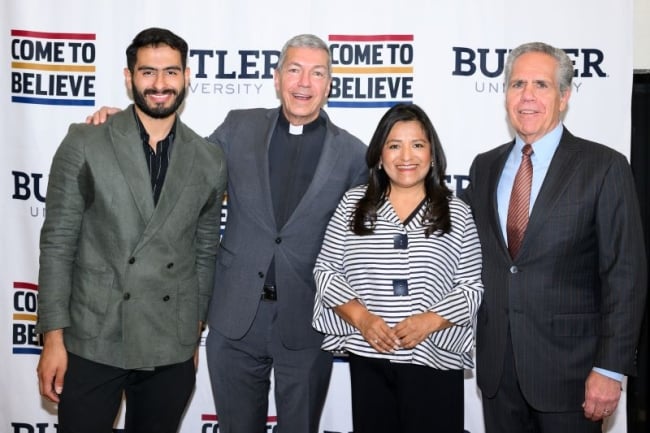You have /5 articles left.
Sign up for a free account or log in.

From left, Carlos Martinez, an Arrupe College alumnus; Father Steve Katsouros, president and CEO of the Come to Believe Network; Marlene Dotson, president and CEO of the Indiana Latino Institute; and Butler University president James Danko gather at a press conference about Butler University’s future two-year college.
Butler University
Butler University, a private institution in Indianapolis, and College of Mount Saint Vincent, a Catholic college in the Bronx borough of New York City, recently announced plans to launch two-year colleges on their campuses with intensive wraparound supports to serve local low-income students.
The two institutions are doing so in partnership with the Come to Believe Network, an organization that helps colleges and universities adopt this model, which started at Loyola University, a Jesuit university in Chicago, eight years ago and is slowly growing in popularity.
Under the model, universities create two-year colleges that serve low-income students and are primarily funded by state and federal financial aid, which reduces costs for the institutions and ensures students take out minimal to no student loans. Students have use of university amenities and receive extra supports, including free breakfast and lunch, laptops, and dedicated faculty advisers and social workers. The students also have the opportunity to transfer seamlessly to the host university. Loyola founded Arrupe College, the first college in the network, in 2015, and University of St. Thomas in Minnesota followed suit two years later when it created Dougherty Family College.
Stephanie Hinshaw, executive director of the Butler Beyond Transformation Lab, a team on campus responsible for helping to launch new educational models, said Butler’s leaders began exploring the model as they were thinking through “how we can really make a Butler education accessible to students who literally live two to three blocks from our campus and feel like it’s out of reach” despite their “high potential.”
Susan Burns, president of the College of Mount Saint Vincent, said as a first-generation college graduate, she’s particularly excited about the model’s possibilities for first-generation students.
She said creating a two-year college on her campus is a way of “leaning into our mission of authentic inclusivity, our commitment to our common humanity, human dignity, and our obligations to each other.”
The Task at Hand
Although Butler’s and Mount Saint Vincent’s programs will follow the same model, they each will also have their own twist.
Butler plans to open its two-year college to an initial cohort of 100 students in fall 2025. They will be able to earn associate degrees in business and allied health—high-demand fields in the area—and a third yet-to-be-determined major. Students at the college will also be placed in paid internships for four of the six semesters of their programs. University officials hope to raise money for scholarships so students who choose to continue their studies at Butler can pay less than $10,000 total for a bachelor’s degree.
The College of Mount Saint Vincent plans to launch Seton College in fall 2024, starting with 100 students who have lower grades than the threshold for acceptance to Mount Saint Vincent and are from low-income backgrounds. They will be able to earn associate degrees in liberal arts, prehealth, business and social sciences. The college also plans to connect them with a variety of part-time job opportunities through partnerships with local employers and will expect them to earn certificates in a preselected skills-based subject provided through Coursera, an online course provider, while earning their associate degrees.
“We know that many of these students, because of the financial need that they and their families come from, they may need to work,” so college leaders wanted to make finding student-friendly jobs as easy as possible, Burns said.
Starting a new college is no small undertaking. Both institutions are currently trying to hire faculty, prepare classroom space, develop academic programming and raise funds.
Hinshaw said about 70 Butler faculty and staff members are working on all the necessary next steps, and university administrators are now looking to hire a dean for the college.
“This is going to transform our whole university, and we’re going to be so much better for it, but we have to prepare for that,” she said.
Burns said the Sisters of Charity, the religious order that founded Mount Saint Vincent, is helping support Seton College, and she expects other donors to come through as well. Mount Saint Vincent is renovating its main academic building so these students will have classrooms and their own gathering areas.
The soon-to-open colleges at Butler and Mount Saint Vincent are the fruit of a Come to Believe Network grant program offered for the first time during the 2022–23 academic year. The program gives $30,000 to universities interested in exploring the model, provided they have high numbers of low-income high school graduates in their surrounding area and enough space on campus to create a two-year college and meet other criteria.
The universities then appoint a project manager and assemble a design team to think through how the model would work on their campuses with guidance from the organization. The Come to Believe Network provides virtual sessions on how to finance new colleges, make them academically successful and deliver the required student supports. University officials also visit Arrupe College. If university leaders decide to proceed, the organization gifts them $500,000 of seed funding that the universities must match.
“I want this to be successful for their students,” said Reverend Steve Katsouros, formerly the inaugural dean at Arrupe College and now president and CEO of the Come to Believe Network. “I’m investing time and eventually financial support because I think this is going to be transformative for students and their communities.”
Four institutions participated in the program in its first year, and Butler and Mount Saint Vincent’s leaders decided to move forward. Eight more institutions are signed up to participate in this year’s grant program.
Student Outcomes
Father Katsouros said the network’s model was born out of a meeting between Jesuit university presidents and board chairs and the head of the Jesuit order a decade ago. Katsouros recalls the Jesuit leader praising their institutions but also saying, “Your tuitions are high—what are you doing for people on the margins?”
Loyola’s response was a model that “celebrated students’ assets, that addressed the barriers that prevented them from being successful,” he said.
He’s been on a years-long campaign to spread the model to other universities after its initial success at Loyola.
“Our first year, we retained 82 percent of our students, and the following year they graduated,” he said. “Most of them went on to four-year institutions, and this kept happening. We had graduation rates of over 50 percent, three-year graduation rates of over 60 percent, and 90 percent of students reported no debt when they completed at Arrupe … I was receiving inquiries weekly, easily, about the model.”
Student success outcomes for Arrupe College and Dougherty Family College have been promising. More than 80 percent of graduates from the two institutions transfer to four-year universities, and 75 percent graduate with a bachelor’s degree, according to data from the Come to Believe Network.
Buffy Smith, dean of Dougherty Family College, said 90 percent of students at her institution are students of color, 80 percent are first-generation students and at least 80 percent are eligible for the Pell Grant, federal financial aid for low-income students. She said the college’s diversity reflects its close, carefully forged ties with community organizations, including boys’ and girls’ clubs, mosques, churches, synagogues, and cultural centers.
The college’s average two-year graduation rate is 56 percent, and 80 percent of students transfer to a four-year institution. Three-fourths of associate degree graduates are currently in or have graduated from a bachelor’s degree program. Since the college’s founding, 313 students earned associate degrees, and 86 students have graduated with four-year degrees, most of them from University of St. Thomas.
Nationally, a little over 31 percent of community college students transfer, and of those who transfer, slightly fewer than half complete a bachelor’s degree within six years, according to a 2022 report from the National Student Clearinghouse Research Center.
Tom Brock, director of the Community College Research Center at Columbia University’s Teachers College, said universities with two-year colleges on their campuses are fairly rare, because community colleges already offer low tuitions that are difficult for universities to compete with and are more likely to have amenities for certain kinds of workforce programs.
He said the model has some clear benefits, including giving students better odds of transferring by exposing them to a university campus and its faculty and students. He added that universities also tend to be “better resourced in terms of the advising and support,” so these students can take advantage of those enhanced resources.
However, Brock also has concerns about the model if it were to spread to universities that charged students high tuitions or had subpar graduation rates.
“I would not want to see your fly-by-night four-year institution, the for-profit four-year institution, competing with community colleges for students,” he said. “That could end up being a very bad deal in the longer run for the students we’re talking about.”
This model could be a “great experience for a small number of students” with valuable ripple effects for them, but “investing in community colleges still needs to be the larger emphasis for public policy,” Brock said.
Smith said she’s excited to see this model spread to other institutions because she believes these high-support two-year colleges grant easier access to higher ed.
“I think it’s reasonable to expect that more universities will do this, because it really is an investment in our collective future,” she said. “It’s a win for equity. It’s a win for our scholars. It’s a win for our nation and ultimately our global community.”





